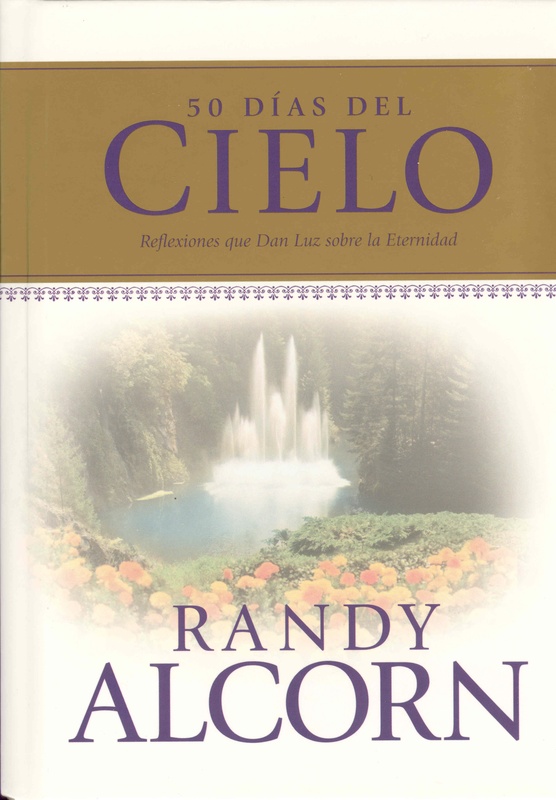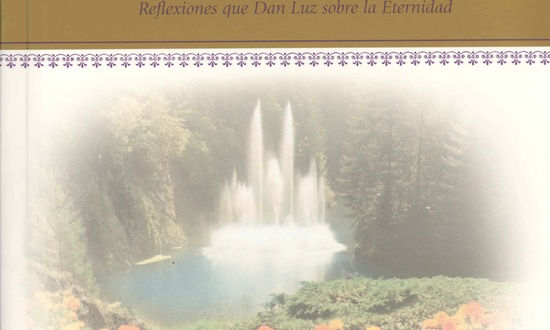Vendré para llevármelos conmigo. Así ustedes estarán donde yo esté. — Juan 14:3
Todas las cosas van a ser glorificadas, aun la naturaleza misma. Y a mí me parece que esa es la enseñanza bíblica del estado eterno: que lo que llamamos cielo es la vida en este mundo perfecto como fue la intención de Dios de que viviera la humanidad. En el principio, cuando él puso a Adán en el paraíso, Adán cayó y todos cayeron con él, pero los hombres y las mujeres fueron hechos para vivir en el cuerpo, y vivirán en un cuerpo glorificado en un mundo glorificado, y Dios estarácon ellos. — Martyn Lloyd-Jones
Muchas personas no pueden resistir espiritualizar lo que la Biblia enseña acerca del Cielo. De acuerdo a un teólogo evangélico: “Aunque el cielo es ambos un lugar y un estado, es principalmente un estado.” ¿Pero qué quiere decir esto? Otro teólogo escribe: “Pablo no piensa en el cielo como un lugar, sino que piensa en términos de la presencia de Dios.” Pero cuando una persona está “presente,” ¿no sugiere eso que hay un lugar?
Un libro pone la palabra lugar entre comillas cada vez que la usa para describir el Cielo o el Infierno. Dice que el paraíso es “más una condición espiritual que un ámbito del espacio.” Pero Jesús no dijo que el Cielo era “principalmente un estado” o una “condición espiritual.” Él habló de una casa con muchos moradas en la cual él prepararía un lugar para nosotros ( Juan 14:2, RV60). En Apocalipsis 21–22, la Nueva Tierra y la Nueva Jerusalén son descritas como lugares reales, con descripciones físicas detalladas, incluyendo piedras preciosas duras y pesadas. ¡Estas descripciones no podrían ser más tangibles!
Jesús les dijo a sus discípulos: “Vendré para llevármelos conmigo. Así ustedes estarán donde yo esté” ( Juan 14:3). Él usa términos comunes, terrenales, que indican espacio para describir el Cielo. La palabra donde se refiere a un lugar, a una localidad. De igual modo, la frase vendré para llevármelos indica movimiento y un destino final.
Si el Cielo no es un lugar, ¿hubiera dicho Jesús que lo era? Si reducimos al Cielo a algo menos de lo que es, despojamos de significado a las palabras de Jesús.
Algunas veces los creyentes han exagerado la noción de que somos extranjeros en este mundo. Por ejemplo, el famoso antiguo canto gospel que dice: “El mundo no es mi hogar, sólo paso por aquí,” expresa una media verdad. Sí, debemos pasar de la Tierra a través de la muerte al Cielo presente, pero finalmente regresaremos a vivir en una Tierra restaurada. Somos peregrinos en esta vida, no porque nuestro hogar nunca será en la Tierra, sino porque nuestro hogar final no es en la Tierra presente (la cual está bajo la maldición). Pero al igual que la Tierra fue una vez el hogar diseñado para nosotros (antes que entrara el pecado), un día de nuevo será nuestro hogar (después que se haya quitado el pecado y la maldición sea revocada).
Debido a que la Tierra ha sido dañada por nuestro pecado (Génesis 3:17), nunca hemos conocido un mundo sin corrupción, sufrimiento y muerte. Sin embargo, anhelamos tal vida y tal mundo. Cuando vemos una catarata y escuchamos el estruendo que produce el agua, cuando vemos hermosas flores, un animal salvaje en su entorno natural, o el gozo en los ojos de nuestras mascotas cuando nos ven, sentimos que este mundo es —o por lo menos se creó para que fuera— nuestro hogar.
¿Retornará el Edén que anhelamos? ¿Será ocupado por cosas familiares, tangibles, tendrá características físicas y personas totalmente corpóreas? La Biblia responde con claridad que sí.
Si queremos saber cómo será el Cielo final, nuestro hogar eterno, el mejor lugar para comenzar es mirar alrededor de nosotros. La Tierra presente es tanto un punto de referencia válido para imaginarnos la Nueva Tierra, como nuestros cuerpos presentes son un punto de referencia válido para imaginarnos nuestros nuevos cuerpos. Pero, ¿podemos mirar la Tierra a nuestro alrededor e imaginar lo que sería no estar perjudicados por la enfermedad y la muerte? ¿Podemos imaginarnos la belleza natural que no esté contaminada por la destrucción? Por supuesto. Personas de todas las creencias se han imaginado un mundo así y lo han representado en su arte, literatura y música.
La idea de una Nueva Tierra como un lugar físico no es una invención de la imaginación humana a la que le falta perspicacia. En realidad, refleja los planes de un Dios trascendente quien hizo seres humanos físicos para que vivieran en una Tierra física, y un Dios inmanente quien eligió convertirse en hombre en esa misma Tierra. Lo hizo para poder redimir a la humanidad y a la Tierra. ¿Por qué? Para glorificarse a sí mismo y disfrutar para siempre de la compañía de los hombres y las mujeres en el mundo que ha hecho para nosotros.
Para tener una cosmovisión cristiana del mundo debemos tener un sentido de nuestro pasado, presente y futuro, y cómo se relacionan entre sí. Si no entendemos el plan original de Dios para la humanidad y la Tierra, no podemos entender su plan futuro.
En los dos primeros capítulos de la Biblia, Dios planta un jardín en la Tierra; en los dos últimos capítulos de la Biblia, él baja a la Nueva Jerusalén, con un jardín en su centro, a la Nueva Tierra. En el Edén no hay pecado, muerte ni maldición; en la Nueva Tierra no hay más pecado, muerte ni maldición. En Génesis, el Redentor es prometido; en Apocalipsis, el Redentor retorna. Génesis relata la historia del paraíso perdido; Apocalipsis relata la historia del paraíso recuperado. En Génesis, se malogra la mayordomía de la humanidad; en Apocalipsis, triunfa la mayordomía de la humanidad, capacitada por el humano y divino Rey Jesús.
Estos paralelos son demasiado notables para ser otra cosa que deliberados. Estas imágenes reflejas demuestran la perfecta simetría del plan de Dios. Nosotros vivimos en el tiempo entremedio, escuchando los ecos del Edén y las pisadas que se aproximan de la Nueva Tierra.
Paul Marshall concluye: “Este mundo es nuestro hogar: fuimos hechos para vivir aquí. Ha sido devastado por el pecado, pero Dios planea arreglarlo. Por lo tanto, esperamos con gozo los cuerpos nuevos restaurados, y vivir en un cielo y tierra recientemente restaurados. Podemos amar este mundo porque es de Dios, y será sanado, llegando a ser finalmente lo que Dios quiso que fuera desde el principio.”
¿Le suena cierto que su hogar no es en la Tierra en su condición presente, sino en la Tierra como será un día?
Padre, ayúdanos a ser cuidadosos para no confundir nuestra relación con la Tierra. Este es el hogar que has hecho para nosotros, y lo redimirás y lo reharás en la Nueva Tierra, donde viviremos para siempre. Gracias, Señor, porque la Tierra es importante. Gracias porque nuestros cuerpos son importantes. Gracias porque los animales, los árboles y los ríos son importantes, y la materia es importante. Abre nuestros ojos al hecho de que has creado todas las cosas y que tu intención fue que manifestaran tu gloria. Gracias de nuevo porque no has abandonado tu creación como tampoco nos has abandonado a nos
The New Earth: A Real Earth?
I will come back and take you to be with me that you also may be where I am. —John 14:3
Everything will be glorified, even nature itself. And that seems to me to be the biblical teaching about the eternal state: that what we call heaven is life in this perfect world as God intended humanity to live it. When he put Adam in Paradise at the beginning, Adam fell, and all fell with him, but men and women are meant to live in the body, and will live in a glorified body in a glorified world, and God will be with them. —Martyn Lloyd-Jones
Many people can’t resist spiritualizing what the Bible teaches about Heaven. According to an evangelical theologian, “While heaven is both a place and a state, it is primarily a state.” But what does this mean? Another theologian writes, “Paul does not think of heaven as a place, but thinks of it in terms of the presence of God.” But when a person is “present,” doesn’t that suggest there’s a place?
One book puts place in quotation marks whenever it uses the word to describe Heaven or Hell. It says paradise is “a spiritual condition more than a spatial location.” But Jesus didn’t say that Heaven was “primarily a state” or a “spiritual condition.” He spoke of a house with many rooms and said he would prepare a place for us (John 14:2). In Revelation 21–22, the New Earth and New Jerusalem are portrayed as actual places, with detailed descriptions of the most substantial, physical substances, including hard and heavy precious stones. These depictions could not be more tangible!
Jesus told the disciples, “I will come back and take you to be with me that you also may be where I am” (John 14:3). He uses ordinary, earthly, spatial terms to describe Heaven. The word where refers to a place, a location. Likewise, the phrase “come back and take you”indicates movement toward a physical destination.
If Heaven isn’t a place, would Jesus have said it was? If we reduce Heaven to something less than or other than a place, we strip Christ’s words of their meaning.
Sometimes Christians have overstated the notion that we are aliens in this world. For instance, the old gospel song, “This world is not my home, I’m just a-passing through,” conveys a half-truth. Yes, we may pass from the earth to the present Heaven through death, but eventually we’ll be back to live forever on the restored Earth. We are pilgrims in this life, not because our home will never be on Earth, but because our ultimate home isn’t on the present Earth (which is under the Curse). But just as the earth was once our intended home (before sin entered), it will one day again be our home (after sin is removed and the Curse is reversed).
Because the earth was damaged by our sin (Genesis 3:17), we have never known a world without corruption, suffering, and death. Yet we yearn for such a life and such a world. When we see a roaring waterfall, beautiful flowers, a wild animal in its native habitat, or the joy in the eyes of our pets when they see us, we sense that this world is—or at least was meant to be—our home.
Will the Eden we long for return? Will it be occupied by familiar, tangible, physical features and fully embodied people? The Bible clearly answers yes.
If we want to know what the ultimate Heaven, our eternal home, will be like, the best place to start is by looking around us. The present Earth is as much a valid reference point for envisioning the New Earth as our present bodies are for envisioning our new bodies. But can we look at the earth around us and imagine what it would be like to be unhindered by disease and death? Can we envision natural beauty untainted by destruction? Of course. People of all beliefs have long imagined such a world and have portrayed it in their art and literature and music.
The idea of the New Earth as a physical place isn’t an invention of a wishful human imagination. Rather, it reflects the plans of a transcendent God, who made physical human beings to live on a physical Earth, and an immanent God, who chose to become a man on that same Earth. He did this that he might redeem mankind and Earth. Why? To glorify himself and enjoy forever the company of men and women in the world that he made for us.
To have a biblical worldview, we must have a sense of our past, present, and future, and how they relate to each other. Without understanding God’s original plan for mankind and the earth, we cannot understand his future plan.
In the first two chapters of the Bible, God plants a garden on Earth; in the last two chapters of the Bible, he brings down the New Jerusalem, with a garden at its center, to the New Earth. In Eden, there’s no sin, death, or Curse; on the New Earth, there’s no more sin, death, or Curse. In Genesis, the Redeemer is promised; in Revelation, the Redeemer returns. Genesis tells the story of paradise lost; Revelation tells the story of paradise regained. In Genesis, humanity’s stewardship is squandered; in Revelation, humanity’s stewardship is triumphant, empowered by the human and divine King Jesus.
These parallels are too remarkable to be anything but deliberate. These mirror images demonstrate the perfect symmetry of God’s plan. We live in the in-between time, hearing echoes of Eden and the approaching footfalls of the New Earth.
Paul Marshall concludes, “This world is our home: we are made to live here. It has been devastated by sin, but God plans to put it right. Hence, we look forward with joy to newly restored bodies and to living in a newly restored heaven and earth. We can love this world because it is God’s, and it will be healed, becoming at last what God intended from the beginning.”
Does it ring true to you that your home is not Earth in its present condition but Earth as it one day shall be?
Father, help us to be careful not to misstate our relationship to the earth. This is the home you made for us, and you will redeem it and refashion it into the New Earth, where we’ll live forever. Thank you, Lord, that the earth matters. Thank you that our bodies matter. Thank you that animals and trees and rivers matter and that matter itself matters. Open our eyes to the fact that you have created all things and intended them to manifest your glory. Thank you again that you have not given up on your creation any more than you have given up on us.
Excerpt from 50 Days of Heaven by Randy Alcorn, Day 14.



